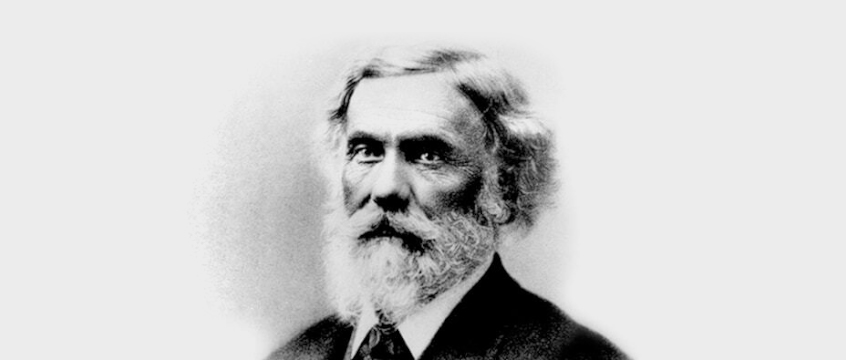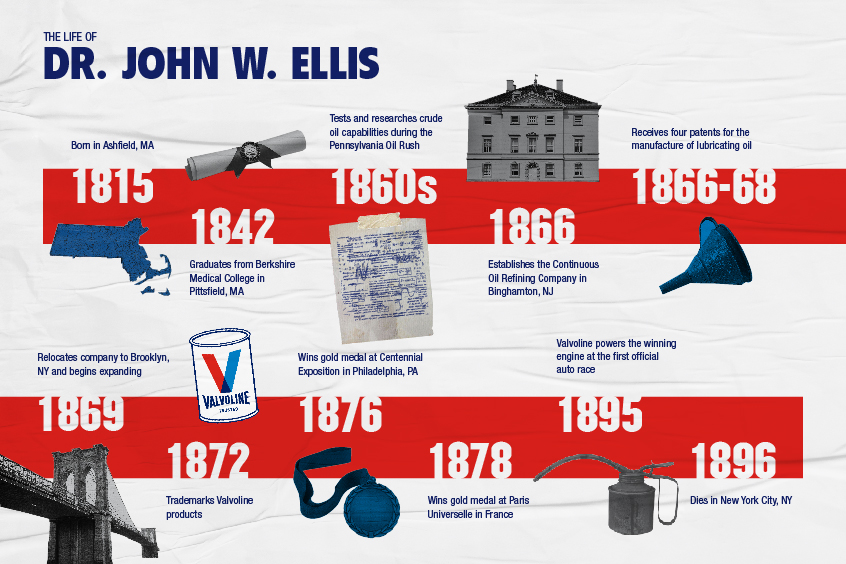Before the discovery of petroleum-based motor oil, animal fat was used to keep complex machines moving. That’s right. Rendered animal fat. If that sounds like it’s not good for critical engine parts to you, then you’re not alone. And you have one man to thank for helping our engines avoid that fate.

Our story begins right after the Civil War in Titusville, PA, the epicenter of the “Pennsylvania oil rush.” Refineries and wells were sprouting up all across the region after a local businessman struck “black gold” near a tributary of the Allegheny River. This discovery attracted prospectors and entrepreneurs from all over who were seeking practical uses for this suddenly abundant resource.
One of those entrepreneurs happened to be the “true original” behind the original motor oil: Valvoline founder Dr. John W. Ellis.
That title isn’t just honorary, either. Dr. Ellis was, in fact, a physician who had established practices in Massachusetts, Michigan, and Pennsylvania. He even spent several years teaching at medical schools in Ohio and New York.
At age 50, Dr. Ellis’s journey was just beginning. He traveled to Titusville in the early 1860s to research the properties of crude oil in hopes of implementing it for medical purposes, but he quickly realized there was no wonder tonic to be found. He did, however, notice it had vast potential for mechanical purposes. After developing his own equipment to test the crude’s capabilities, Dr. Ellis discovered a new process that improved its lubricating qualities by using steam heat rather than direct heat.
As fortune would have it, Dr. Ellis quickly found a way to capitalize on his newfound discovery. In 1866, Ezekiel Crocker Leonard—Dr. Ellis’s wife’s sister’s husband—was struggling to maintain his oil refinery in Binghamton, NJ, so he consulted Dr. Ellis for assistance. This new partnership resulted in the Continuous Oil Refining Company, whose purpose was to manufacture lubricating oil from petroleum for steam engines and other machines.
Over the course of the next two years, Dr. Ellis secured a total of four patents to support his groundbreaking new product: an “all-petroleum, high-viscosity steam cylinder lubricant” capable of performing under high temperatures. The days of slathering machine parts with animal fat were going to be a thing of the past.
Seeing enormous potential and needing a better name than “not animal fat to grease your engine,” Dr. Ellis came up with a new name for his product in 1868. He stuck together the word valve, plus the Latin word for oil (oleum), and the ending -ine to indicate a chemical compound equals success. Thus the word Valvoline was trademarked and an American icon was born.
But the founding father of petroleum-based engine oil wasn’t satisfied with just being first. Pretty soon, Dr. Ellis’s business plan outgrew the refinery in Binghamton, so in 1869, he built a new refinery in Brooklyn, NY, closer to the ever-growing center of American commerce. With brand new production capacity and access to new markets, Dr. Ellis and his son, Wilbur Dixon Ellis, developed and manufactured an array of their own petrol products, including petroleum jellies, compounded oils, and kerosene illuminants. But none was more impactful than their flagship lubricating engine oil.

Over the next decade, he opened branch offices and bulk plants in Boston, MA; Chicago, IL; Philadelphia, PA; and San Francisco, CA to meet increasing demand from the rapid growth of steam-generated electricity and locomotives. By now, the product had spread overseas as Dr. Ellis was trading with companies in England, France, and Germany. Dr. Ellis’s discovery had become a global sensation.
Valvoline even drew the attention of President Ulysses S. Grant in 1876. At the Centennial Exposition in Philadelphia, PA, Valvoline won the top prize for excellence in lubricants technology, a victory topped off by a demonstration with the Corliss steam engines that were powering the event. These engines, smoothly running with Valvoline oils, were started up by President Grant himself.
After spending more than three decades at his second career, Dr. John W. Ellis passed away in 1896. He saw his invention improve the technology powering America’s growing industrial might, but he only caught a glimpse of its most significant contribution to American culture. You see, Dr. Ellis had pioneered his product for steam in the 1860s, when a combustion-driven automobile was still an idea being tinkered on by inventors and dreamers. And even though he never saw how his product helped shape the culture of America, his life was able to overlap one monumental event in automotive history.
A year before his death in 1895, the very first official auto race in history was held just outside Chicago, IL. Fittingly enough, the car that won that race was running with Valvoline protecting its engine.

